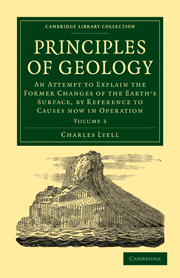 Principles of Geology
Principles of Geology Book contents
- Frontmatter
- PREFACE
- Contents
- LIST OF PLATES AND WOOD-CUTS IN THE THIRD VOLUME
- LIST OF WOOD-CUTS
- ERRATA
- CHAPTER I
- CHAPTER II
- CHAPTER III
- CHAPTER IV
- CHAPTER V
- CHAPTER VI
- CHAPTER VII
- CHAPTER VIII
- CHAPTER IX
- CHAPTER X
- CHAPTER XI
- CHAPTER XII
- CHAPTER XIII
- CHAPTER XIV
- CHAPTER XV
- CHAPTER XVI
- CHAPTER XVII
- CHAPTER XVIII
- CHAPTER XIX
- CHAPTER XX
- CHAPTER XXI
- CHAPTER XXII
- CHAPTER XXIII
- CHAPTER XXIV
- CHAPTER XXV
- CHAPTER XXVI
- Table I Showing the relations of the various classes of rocks, the Alluvial, the Aqueous, the Volcanic, and the Hypogene, of different periods
- Table II Showing the order of superposition of the principal European groups of sedimentary strata mentioned in this work
- Notes in explanation of the Tables of fossil shells in Appendix I
- Appendix I Tables of fossil shells by Monsieur G. P. Deshayes
- Appendix II Lists of fossil Shells chiefly collected by the author in Sicily and Italy, named by M. Deshayes
- Glossary, containing an explanation of geological and other scientific terms used in this work
- Index
- WORKS ON SCIENCE AND NATURAL HISTORY
- Plate section
- Frontmatter
- PREFACE
- Contents
- LIST OF PLATES AND WOOD-CUTS IN THE THIRD VOLUME
- LIST OF WOOD-CUTS
- ERRATA
- CHAPTER I
- CHAPTER II
- CHAPTER III
- CHAPTER IV
- CHAPTER V
- CHAPTER VI
- CHAPTER VII
- CHAPTER VIII
- CHAPTER IX
- CHAPTER X
- CHAPTER XI
- CHAPTER XII
- CHAPTER XIII
- CHAPTER XIV
- CHAPTER XV
- CHAPTER XVI
- CHAPTER XVII
- CHAPTER XVIII
- CHAPTER XIX
- CHAPTER XX
- CHAPTER XXI
- CHAPTER XXII
- CHAPTER XXIII
- CHAPTER XXIV
- CHAPTER XXV
- CHAPTER XXVI
- Table I Showing the relations of the various classes of rocks, the Alluvial, the Aqueous, the Volcanic, and the Hypogene, of different periods
- Table II Showing the order of superposition of the principal European groups of sedimentary strata mentioned in this work
- Notes in explanation of the Tables of fossil shells in Appendix I
- Appendix I Tables of fossil shells by Monsieur G. P. Deshayes
- Appendix II Lists of fossil Shells chiefly collected by the author in Sicily and Italy, named by M. Deshayes
- Glossary, containing an explanation of geological and other scientific terms used in this work
- Index
- WORKS ON SCIENCE AND NATURAL HISTORY
- Plate section
Summary
ON THE ROCKS COMMONLY CALLED PRIMARY.
We shall now treat of the class of rocks usually termed ‘primary’ a name which, as we shall afterwards show, is not always applicable, since the formations so designated sometimes belong to different epochs, and are not, in every case, more ancient than the secondary strata. In general, however, this division of rocks may justly be regarded as of higher antiquity than the oldest secondary groups before described, and they may, therefore, with propriety be spoken of in these concluding chapters, for we have hitherto proceeded in our retrospective survey of geological monuments from the newer to those of more ancient date.
In order to explain to the reader the relation which we conceive the rocks termed ‘primary’ to bear to the tertiary and secondary formations, we shall resume that general view of the component parts of the earth's crust of which we gave a slight sketch in the preliminary division of our subject in the 2nd chapter.
We there stated that sedimentary formations, containing organic remains, occupy a large part of the surface of our continents, but that here and there volcanic rocks occur, breaking through, alternating with, or covering the sedimentary deposits, so that there are obviously two orders of mineral masses formed at the surface which have a distinct origin, the aqueous and the volcanic.
- Type
- Chapter
- Information
- Principles of GeologyAn Attempt to Explain the Former Changes of the Earth's Surface, by Reference to Causes now in Operation, pp. 352 - 364Publisher: Cambridge University PressPrint publication year: 2009First published in: 1833


